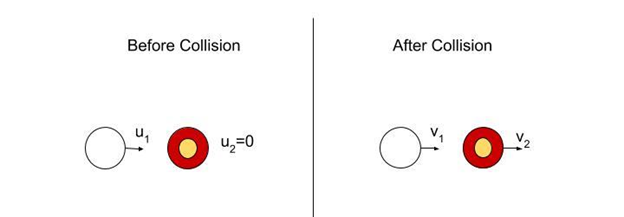
A cue ball moving at 5 ft/s to the right, strikes another billiard ball of equal mass. If the coefficient of restitution between the two is 0.8, find the speed of the cue ball after impact.
A) 1.2 ft/s to the right
B) 0 (it stops completely)
C) 0.5 ft/s to the right
D) -1.2 ft/s to the left
Answer
558.6k+ views
Hint: The problem has to be solved by applying law of conservation of momentum, which states that, “for two or more colliding bodies the total momentum before and after the collision is conserved if no external force acts on them.” The other concept is the coefficient of restitution which is defined as the ratio of relative velocity after collision to the relative collision before collision.
Complete step by step answer:

As stated in the problem, the masses of the two balls are the same hence, $m_1 = m_2 = m$.
Applying law of conservation of momentum to the given problem we get,
$m{u_1} + m{u_2} = m{v_1} + m{v_2}$
Assuming, ball 2 to be at rest before collision, i.e. $u_2$= 0. Now, substituting values of $u_2$ & $u_1$ in above equation and also dividing it by m we get,
${v_1} + {v_2} = 5$......................(1)
Now, the formula for coefficient of restitution is given as,
$e = \dfrac{{{v_2} - {v_1}}}{{{u_1} - {u_2}}}$
Put e =0.8 in above equation and also put the values of $u_2$ & $u_1$,
$0.8 = \dfrac{{{v_2} - {v_1}}}{{5 - 0}}$
${v_2} - {v_1} = 4$......................(2)
Solving, equations (1) & (2) we get,
${v_1} = 0.5$
Hence, the ball will continue to travel in the same direction with the speed of 0.5 ft/s. Hence, option (C) is the correct choice.
Note: The problems of such type will always have two unknowns to be found. It requires two equations to find solutions for two unknowns. One equation can be obtained by applying the law of conservation of momentum while the other can be obtained by applying the formula for coefficient of restitution. If coeff. of restitution is not provided the chec for any extra condition provided in the question.
Complete step by step answer:

As stated in the problem, the masses of the two balls are the same hence, $m_1 = m_2 = m$.
Applying law of conservation of momentum to the given problem we get,
$m{u_1} + m{u_2} = m{v_1} + m{v_2}$
Assuming, ball 2 to be at rest before collision, i.e. $u_2$= 0. Now, substituting values of $u_2$ & $u_1$ in above equation and also dividing it by m we get,
${v_1} + {v_2} = 5$......................(1)
Now, the formula for coefficient of restitution is given as,
$e = \dfrac{{{v_2} - {v_1}}}{{{u_1} - {u_2}}}$
Put e =0.8 in above equation and also put the values of $u_2$ & $u_1$,
$0.8 = \dfrac{{{v_2} - {v_1}}}{{5 - 0}}$
${v_2} - {v_1} = 4$......................(2)
Solving, equations (1) & (2) we get,
${v_1} = 0.5$
Hence, the ball will continue to travel in the same direction with the speed of 0.5 ft/s. Hence, option (C) is the correct choice.
Note: The problems of such type will always have two unknowns to be found. It requires two equations to find solutions for two unknowns. One equation can be obtained by applying the law of conservation of momentum while the other can be obtained by applying the formula for coefficient of restitution. If coeff. of restitution is not provided the chec for any extra condition provided in the question.
Recently Updated Pages
Master Class 11 Economics: Engaging Questions & Answers for Success

Master Class 11 English: Engaging Questions & Answers for Success

Master Class 11 Social Science: Engaging Questions & Answers for Success

Master Class 11 Biology: Engaging Questions & Answers for Success

Class 11 Question and Answer - Your Ultimate Solutions Guide

Master Class 11 Business Studies: Engaging Questions & Answers for Success

Trending doubts
What is meant by exothermic and endothermic reactions class 11 chemistry CBSE

10 examples of friction in our daily life

One Metric ton is equal to kg A 10000 B 1000 C 100 class 11 physics CBSE

Difference Between Prokaryotic Cells and Eukaryotic Cells

What are Quantum numbers Explain the quantum number class 11 chemistry CBSE

1 Quintal is equal to a 110 kg b 10 kg c 100kg d 1000 class 11 physics CBSE




